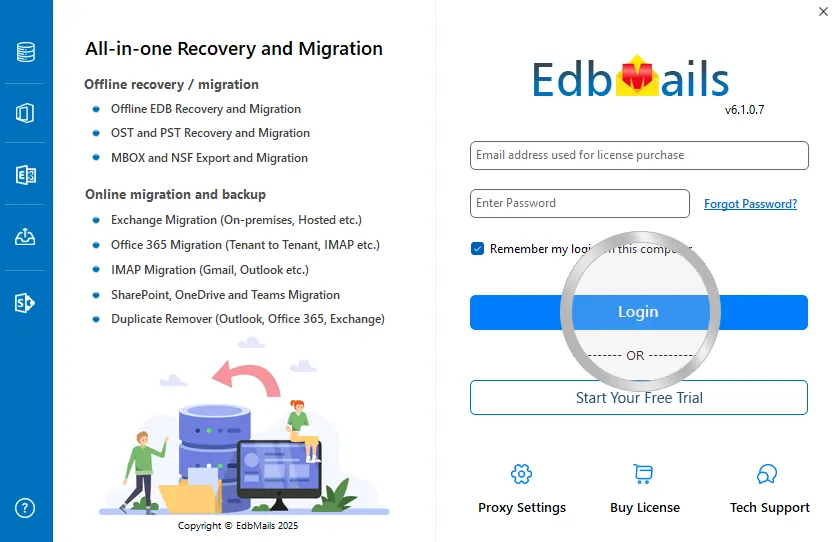- Reseller
- Products Exchange EDB / Email Recovery Tools
- EDB Recovery and MigrationRecover EDB to PST, EDB to Office 365 and Exchange NO Duplicate Migration
- OST Recovery and MigrationRecover OST to PST, OST to Office 365 and Exchange Migration
- PST Recovery and MigrationRecover Outlook PST, PST to Office 365 and Exchange Migration
- MBOX Export and MigrationExport MBOX to PST, MBOX to Office 365 and Exchange Migration
- NSF Export and MigrationExport NSF to PST, NSF to Office 365 and Exchange Migration
- EML to PST ExportEML files export to Outlook PST format
- PST to MSG ExportOutlook PST files export to MSG format
- MSG to PST ExportExport MSG files Outlook PST files
Exchange and Office 365 Migration- Exchange Server MigrationMigrate Exchange 2007, 2010, 2013, 2016, 2019 to Office 365 tenants. Also, migrate between Exchange servers and PST
- Office 365 MigrationMigrate Source Office 365 tenants to Destination Office 365 tenants. Also, migrate to Exchange Server and PST
- IMAP Email Backup & MigrationMigrate all IMAP email servers (Gmail, Zimbra, Zoho, Yahoo etc.), Office 365, Exchange and Backup to Outlook PST
- SharePoint Online MigrationMigrate documents, files and folders from SharePoint sites
- OneDrive for Business MigrationMigrate documents, files and folders from OneDrive
- Microsoft Teams MigrationMigrate Teams, documents, files and folders etc.
Exchange and Office 365 Backup- Office 365 BackupIncremental, Granular, Encrypted and Compressed Office 365 Mailboxes Backup
- Exchange Server BackupIncremental, Granular, Encrypted and Compressed Exchange Mailboxes Backup
- SharePoint, OneDrive & Teams BackupBackup Online site collections, Team sites, Office 365 groups, all documents etc.
- Duplicate Remover - Office 365, Exchange, IMAP & Outlook Remove duplicate emails, calendars, contacts, journal etc. from Office 365, Exchange, IMAP, Outlook, Gmail, Zimbra, Zoho Mail etc.
- More Products
- Features
- Video Tutorials
- Free Tools
- FAQ
- Knowledge Base
Knowledge Base
Get an instant help and tips on how to use and get the most out of your EdbMails tools.
How can we help you?
Search our Knowledge Base to quickly find answers to your questions.
Impact of Exchange throttling policy on EdbMails
This article explains throttling and how the Exchange throttling policy impacts the functionality of EdbMails. Additionally, it also describes how to control Exchange throttling policies
What is throttling?
Throttling is a reactive response against over utilization of system resources that may affect service reliability and functionality. It imposes a limit on the number of concurrent call requests that can be executed at the same time.
How does Exchange throttling policy affect EdbMails?
Exchange throttling policy affects the backup and migration speed and displays errors during the operation with EdbMails. Throttling is one of the reasons for the errors related to insufficient impersonation rights that may appear frequently.
How to avoid throttling issues?
Create a custom throttling policy with limits higher than the default ones or even disable these limits and assign it to the user account used in the EdbMails application during migration.
Steps to create a custom throttling policy
You can create custom throttling policies with limits greater than the default in an on-premises Exchange environment. You can also disable these restrictions completely if necessary. To perform the backup and/or migration operation, you can assign this policy to the user account used in EdbMails. However, proceed with caution and ensure that your Exchange servers can handle the increased number of concurrent queries. To customize the throttling policy, follow the below steps.
- Open Exchange Management Shell (EMS).
- Run the following cmdlet to check current throttling
Get-ThrottlingPolicy | fl
- Run the following cmdlet to create a new throttling policy
New-ThrottlingPolicy <Throttling_Policy_Name>
For example:
New-ThrottlingPolicy EdbMailsPolicy
- The New policy settings have to be reconfigured in a way that does not hinder the backup or migration tasks. Use $null or Unlimited values to use custom values or to disable the limitation.
For Exchange Server 2010 version:
Set-ThrottlingPolicy EdbMailsPolicy -RCAMaxConcurrency $null -EWSMaxConcurrency $null-EWSMaxSubscriptions $null -CPAMaxConcurrency $null
For Exchange Server 2013 and later versions:
Set-ThrottlingPolicy EdbMailsPolicy -RCAMaxConcurrency Unlimited -EWSMaxConcurrency Unlimited-EWSMaxSubscriptions Unlimited -CPAMaxConcurrency Unlimited -EwsCutoffBalanceUnlimited -EwsMaxBurst Unlimited -EwsRechargeRate Unlimited
If you want to know how to change the throttling policies in Exchange 2010, 2013, 2016 and 2019, refer to Microsoft's website.
- After you change the throttling policy, make sure to assign it to particular accounts.
- Run the following cmdlet to assign the newly created policy (e.g. EdbMailsPolicy) to the admin account used for migration in EdbMails application:
Set-Mailbox "<mailbox name>" -ThrottlingPolicy EdbMailsPolicy
The parameter 'mailbox name' is the mailbox name or alias address.
Use the following cmdlet to assign the throttling policy to all users in an organization:
Set-ThrottlingPolicy "EdbMailsPolicy" -ThrottlingPolicyScope Organization
Click here for EdbMails Exchange Migration steps
Related topics:
- Troubleshooting Public Folder Migration
- How many mailboxes licenses are required for Public folder Migration?
- Difference between Personal, Corporate and Technical Edition
- Office 365 Backup Pricing
- MBOX Export and Migration Pricing
- NSF Export and Migration Pricing
- Outlook PST Recovery Pricing
- OST Recovery and Migration Pricing
- The underlying connection was closed
- ErrorExceededConnectionCount
EdbMails Demo / Trial Version
Step 1. Download and install EdbMails
Step 2. Click the 'Start Your Free Trial' button


Hi, May I help you?
Hide Chat Now